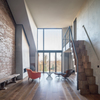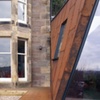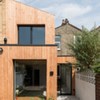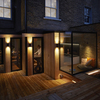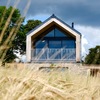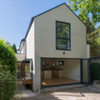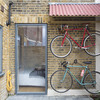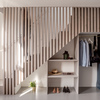Scissor Truss House
Subscribe now to instantly view this image
Subscribe to the Architects’ Journal (AJ) for instant access to the AJ Buildings Library, an online database of nearly 2,000 exemplar buildings in photographs, plans, elevations and details.
Already a subscriber? Sign in
Scissor Extension Daylight
Adam Woodward (website) Download Original
Refurbishment, remodelling and extension of a early 1900s diary cottage in Streatham.
Architects and Interior Designers Studio MESH have taken the variable pitches of an early 1900s dairy cottage in south London as precedent for a simple pitched roof extension. The design generates a contemporary and serene space, resisting modernist tropes in a contextually sensitive and considered manner
The brief centred around the remodelling and extending of a one bedroom flat into a two-bedroom flat, transforming it into a comfortable and efficient place to escape a busy London life. The rear of the large garden has mature trees and the aesthetic of branches overhead evolved into an exposed truss roof for the primary living space that overlooks and connects to this area. The challenge of a very small budget led to a design approach that focused on imaginative use of standard materials, bringing quality through complexity and invention
In a world focussing on the mass produced, robotic automation and factory-made, Studio MESH chose to celebrate the handmade. Construction was primarily undertaken by the two brothers who owned the property, vesting the satisfaction of personal creation. The primary construction of the extension is a simple brickwork and timber structure, the scissor truss design of the timber roof avoids lateral loading of the walls and allows for minimal steel framework. It was constructed by hand on site, each truss uses only three pins and four flat bars to fix its five timber components together
The structural concrete slab is positioned above the insulation to make use of its thermal mass, it also incorporates underfloor heating and has been grinded with an industrial concrete polishing machine to make a warm and luxurious finish for minimal cost. Glazing of the end gable is carefully detailed to appear frameless and makes use of the steel framework required to provide support for the wall ends. Outside the brickwork is painted white to bring light into the side passages and defines the new from the old. Above a sedum green roof improves on the biodiversity of the existing footprint of the building which had a clay tile roof
The bathroom is tiled in commercial ceramic tiles hand cut into a chevron shape that is made to measure in the space available. Simple copper brackets provide high quality and energy efficient LED lighting and double up as heat sinks. The sofa, dining table and kitchen are all bespoke designs that have originated as waste or low-quality materials and been transformed into unique and stylish pieces of furniture that are wedded to the theme of the extension. The primary aim was to create a crafted space that has a human touch.
Data
- Begun: Feb 2017
- Completed: Dec 2017
- Floor area: 77m2
- Sector: Residential
- Total cost: £39,500
- Funding: Private
- Procurement: JCT Homeowners Contract
- CO2 Emissions: 54.5kg/m2/year
- Address: 77 Valley Road, Streatham, London, SW16 2XL, United Kingdom
Professional Team 
- Architect: Studio MESH
- Client: Henry & Alec Smith
- Interior Designer : Studio MESH
- Structural engineer : Axiom
Suppliers
- Green roof: Bauder
- Bespoke furniture: Studio MESH
- Kitchen Consultant & Supplier: Studio MESH
- Furniture supplier: SmithMatthias
- Lighting design and manufacture: Studio MESH
- Furniture: Very Good and Proper








































